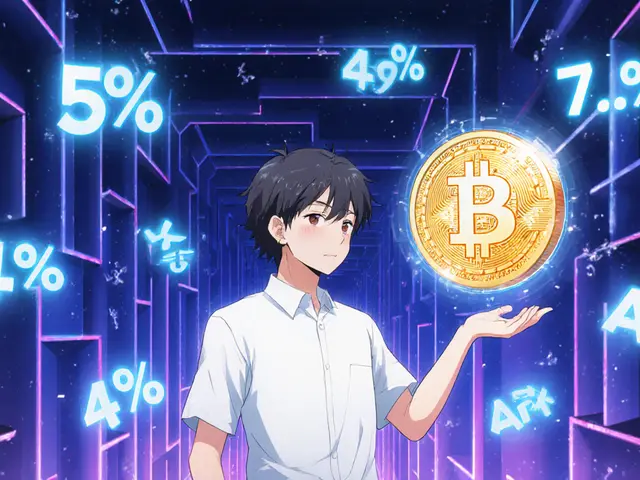Slashing Penalty Calculator
Penalty Breakdown
Estimated Penalty:
Percentage of Stake:
Network:
Offense:
Slashing Penalty Reference Table
| Network | Double-Signing | Downtime (per epoch) | Network Manipulation |
|---|---|---|---|
| Ethereum | ~1 ETH (1/32) | 0.07 ETH per 36-day exit | Full stake burned |
| Cosmos | 5% of stake | 0.01% per missed block | 100% of stake |
| Polkadot | 10% (first offense) | 0.5% per era missed | Full stake |
| Cardano | 0.1% per double-sign | 0.02% per missed slot | Up to 5% |
| Solana | 0.1 SOL | 0.001 SOL per missed slot | Full stake |
Quick Take
- Slashing penalties are economic punishments that kick in when a validator breaks protocol rules.
- Ethereum slices about 1ETH (≈1/32 of the stake) for a first‑offence, while Cosmos and Polkadot use configurable percentages.
- Double‑signing draws the harshest fines - often the full stake is burned.
- Downtime penalties grow with the length of the outage; most networks charge per epoch or per block missed.
- Protect yourself with remote signers, sentry nodes, and real‑time monitoring to keep slashing risk low.
When you hear the term slashing penalty is a cryptoeconomic mechanism that removes a portion of a validator’s stake when they violate consensus rules, it often sounds like a vague concept. In reality, each proof‑of‑stake (PoS) network has carved out a very specific formula, and the numbers can differ by an order of magnitude. This guide walks you through the most common offenses, shows how the big players - Ethereum, Cosmos, Polkadot, Cardano, and Solana - calculate the hit, and gives you practical steps to dodge costly slashes.
Why Slashing Exists: The Economic Guardrail
PoS relies on validators staking assets as a security bond. If a validator tries to game the system, the network needs a deterrent that’s both painful and predictable. By burning or forfeiting part of the staked amount, the protocol aligns financial incentives with honest behavior, keeping the chain safe without relying on expensive mining hardware.
Experts at a16z stress that the penalty must be “just enough to scare off attackers but not so brutal that honest participants quit”. Striking that balance is why every blockchain tweaks its parameters as the ecosystem matures.
Slashable Offenses in a Nutshell
Most PoS chains group violations into three buckets:
- Double‑signing occur when a validator signs two different blocks or attestations for the same slot. This can split consensus and is treated as the most severe breach.
- Downtime happens when a validator is offline and misses its duty to propose or attest blocks. Penalties scale with the length of the outage.
- Network manipulation covers actions like signing multiple blocks for the same slot or trying to rewrite history. These are often punished with full‑stake forfeiture.
How the Major Blockchains Slice the Stake
Below is a snapshot of the current (Oct2025) slashing formulas for the five most‑used PoS networks. Values are expressed in the native token and assume a validator holds the typical minimum stake.
| Network | Minimum Stake | Double‑Signing Penalty | Downtime Penalty (per epoch) | Network Manipulation Penalty |
|---|---|---|---|---|
| Ethereum a layer‑1 PoS chain that launched the Beacon Chain in 2020 | 32ETH | ~1ETH (1/32 of stake) + possible full‑stake loss if repeated | 8,000GWei per missed epoch ≈0.07ETH over 36‑day exit period | Full stake (32ETH) burned |
| Cosmos a modular PoS ecosystem used by dozens of zones | 10ATOM | 5% of stake (0.5ATOM) | 0.01% of stake per missed block (≈0.001ATOM per epoch) | 100% of stake |
| Polkadot a heterogeneous multi‑chain network with pooled security | 40DOT | 10% of stake (4DOT) for first offense, up to 100% for repeat | 0.5% of stake per era missed (≈0.2DOT per era) | Full stake (40DOT) |
| Cardano a research‑driven PoS platform using Ouroboros | 500ADA | 0.1% of stake per double‑sign (0.5ADA) - capped at 5% total | 0.02% of stake per missed slot (≈0.1ADA per epoch) | Up to 5% of stake |
| Solana a high‑throughput PoS chain with a Turbine network layer | 1SOL | Fixed 0.1SOL for double‑sign | 0.001SOL per missed slot | Full stake (1SOL) |

Breaking Down the Numbers: Real‑World Scenarios
Imagine you run a single validator on each network and experience a 6‑hour outage. Here’s what you’d lose:
- Ethereum: About 0.07ETH (≈$120) extra on top of the 1ETH initial slash if the chain deems it a fault.
- Cosmos: Roughly 0.006ATOM (≈$0.12) - tiny, but repeated outages add up.
- Polkadot: Around 0.2DOT (≈$5) per era missed; multiple eras mean a noticeable hit.
- Cardano: ~0.1ADA per epoch; negligible in isolation.
- Solana: 0.001SOL per slot, which quickly becomes 0.06SOL for a 6‑hour gap (~$3).
While the dollar value differs, the principle stays the same: downtime penalties are proportional, and double‑signing can wipe you out.
Best Practices to Keep Your Stake Safe
Validators across all chains converge on a handful of hard‑earned habits:
- Remote signer architecture: Keep the signing key on an isolated machine behind a firewall. Only the validator client talks to it.
- Sentry nodes: Deploy one or more front‑end nodes that absorb DDoS traffic. The actual validator never faces the public internet directly.
- Automated monitoring: Use tools like Prometheus + Grafana, or chain‑specific dashboards, to alert on missed slots, high latency, or key rotation failures.
- Slash protection databases: Services such as Stakefish or Figment maintain a list of known bad signatures and can pre‑empt a double‑sign event.
- Insurance & liquid‑staking coverage: New products let you buy a policy that reimburses up to a set amount if you get slashed, turning a catastrophic loss into a manageable expense.
For newcomers, the quickest path to safety is to start with a reputable staking service that offers built‑in slash protection. Once you’re comfortable, you can graduate to self‑run infrastructure.
Emerging Trends: From Fixed Penalties to Reputation Scores
The next wave of slashing research focuses on smarter, context‑aware punishments. Some proposals on Ethereum’s roadmap suggest weighting penalties by:
- Validator’s historical uptime record.
- Network congestion at the time of the offense.
- Intent detection (e.g., distinguishing a genuine software bug from malicious behavior).
Other chains, like newer Layer‑1s built on the Cosmos SDK, are experimenting with “reputation tokens” that lower future slashing fractions for validators who consistently stay online. Meanwhile, liquid‑staking protocols (Lido, Coinbase Staked) are spreading the loss across token holders, making the impact less painful for any single participant.
Quick Checklist for Validator Operators
- Know your network’s exact slashing fractions (store them in a notebook).
- Run at least two independent nodes: one “sentry”, one “validator”.
- Enable real‑time alerts for missed blocks or failed proposals.
- Back up signing keys offline and rotate regularly.
- Consider insurance or slash‑protection services if you stake >100k USD worth of assets.
Frequently Asked Questions
What triggers a slashing event on Ethereum?
Ethereum slashes a validator when it detects double‑signing, surround‑signing (signing multiple blocks for the same slot), or prolonged inactivity that leads to missed attestations. The protocol’s validator client logs and the beacon chain’s consensus module raise the slash flag automatically.
Can I recover my stake after a slash?
Only the portion that wasn’t seized is returned. For Ethereum, the remaining balance (up to 31ETH) stays locked for the exit period before you can withdraw. Some networks, like Polkadot, allow you to re‑bond with newly acquired tokens after the slash.
Is downtime slashing proportional to the length of the outage?
Yes. Most chains calculate a per‑epoch (or per‑slot) penalty. The longer you stay offline, the larger the cumulative loss. For example, Cosmos takes 0.01% of the stake for each missed block.
Do liquid‑staking services absorb slashing losses?
They spread the loss across all token holders. If a validator under a liquid‑staking pool gets slashed, each holder’s share of the pool shrinks proportionally, instead of the individual validator bearing the full hit.
How can I estimate my potential slashing risk before staking?
Run a test node in “observer” mode for a few weeks, monitor uptime, and simulate fault scenarios using the network’s dev tools. Combine this with the published slashing fractions to model worst‑case losses.







Comments
Michael Wilkinson
September 16, 2025 AT 04:24 AMIf you think slashing is just a random penalty, you’re seriously mistaken.
MD Razu
September 19, 2025 AT 06:07 AMWhen we peer into the abyss of blockchain governance, we encounter a paradox where security and freedom dance on a razor’s edge, each slash a reminder that trust is not given but continuously earned. The very act of penalizing validators is a manifestation of a collective social contract, an implicit promise that the network will punish negligence as fiercely as it rewards reliability. Yet, this contract is not immutable; it evolves with each fork, each protocol upgrade, and each new economic incentive that designers introduce. In Ethereum, the one‑ETH slash for double‑signing seems trivial compared to the total stake, but its symbolic weight is massive, echoing a deeper philosophical truth: the loss of reputation can outweigh material loss. Cosmos’s 5% penalty for double‑signing, on the other hand, quantifies risk in a way that feels almost mercantile, as if the network is merely a ledger of debts. Polkadot’s escalating slash for repeated offenses suggests a learning system – a validator that errs once is warned, but repeated transgressions draw steeper cuts, mirroring human societies that impose harsher punishments on repeat offenders. Cardano’s minuscule 0.1% double‑sign penalty may appear lenient, yet in a system where staking pools can amass millions of ADA, even a fraction can translate into substantial sums. Solana’s fixed 0.1 SOL slash is an odd hybrid, offering simplicity at the cost of proportional fairness. Each of these mechanisms, while technically distinct, share a common narrative: they are designed to align individual validator incentives with the health of the whole ecosystem. If we ignore this alignment, we risk fragmenting the network, allowing rogue actors to undermine consensus without consequence. Moreover, the very calculation of downtime penalties, be it per‑epoch or per‑slot, introduces a probabilistic element that can be gamed if not properly monitored. The presence of liquid‑staking services adds another layer of complexity, as they distribute slashing losses across token holders, diluting individual accountability. Ultimately, the philosophical question remains: should a decentralized protocol enforce punitive measures, or should it rely on market forces and validator reputation alone? The answer, perhaps, lies in a hybrid model that balances deterministic slashing with flexible community governance, allowing the network to adapt as threats evolve. In any case, understanding these nuances is essential for any validator who wishes to navigate the treacherous waters of modern proof‑of‑stake blockchains.
Charles Banks Jr.
September 22, 2025 AT 07:50 AMWow, look at you with the fancy table – as if anyone actually reads these numbers before they get zapped. Guess most folks just copy‑paste the calculator and hope for the best. Good luck staying online on Cosmos, those 0.01% per missed block add up faster than my coffee intake.
Ben Dwyer
September 25, 2025 AT 09:33 AMTake this as a reminder: always monitor your node’s uptime and keep a backup validator ready. If you diversify across multiple networks, you spread the risk and can afford a small slip without jeopardizing your whole portfolio.
VICKIE MALBRUE
September 28, 2025 AT 11:16 AMStay positive keep learning slashing is just part of the journey
Waynne Kilian
October 1, 2025 AT 12:58 PMi totally agree with vickie but also remind u that sometimes the docs can be a lil confusing maybe double check the latest github updates for any hidden fee changes
Naomi Snelling
October 4, 2025 AT 14:41 PMEveryone talks about slashing like it’s just a technical glitch, but have you ever considered that the real motive is centralized control? The big players want us to fear the penalty so they can push their own validators into power.
Billy Krzemien
October 7, 2025 AT 16:24 PMWhile it’s natural to be cautious, the consensus mechanisms are open‑source and auditable. The penalties exist to protect the network, not to serve hidden agendas. Running your own node and reviewing the code can demystify these fears.
april harper
October 10, 2025 AT 18:07 PMThe tragedy of slashing is that it turns every validator into a lone wolf, haunted by the ghost of missed slots.
Clint Barnett
October 13, 2025 AT 19:50 PMLet’s unpack the practical side of this calculator. First, you need to know your exact stake size because many of these percentages are relative. For Ethereum, a single ETH slash might not look like much, but if you’re running a 32‑ETH validator that’s a full 3% of your deposit. In Cosmos, the 5% double‑sign is applied directly to whatever amount you locked, so a 10‑ATOM validator loses half an ATOM instantly. Polkadot’s 10% first‑offense slash can be mitigated if you have a “bond” that you can re‑bond after the slash, but you still lose liquidity for the duration of the unbonding period. Cardano’s 0.1% per double‑sign is almost negligible on paper, yet when you stake 500 ADA, that’s half an ADA each time you slip. Solana’s fixed 0.1 SOL may appear tiny, but given SOL’s price volatility, it can swing wildly in USD terms. Downtime penalties accumulate per epoch or per slot, so the longer you’re offline, the more you lose – think of it as a linear function: missed slots × rate. If you’re running a validator on multiple chains, you should set up alerts for each network’s heartbeat. Also, remember that many liquid‑staking services charge an additional fee on top of the base slash, effectively spreading the loss across pool participants. Finally, keep an eye on upcoming governance proposals; rates can shift after each major upgrade, so the calculator you use today might be outdated tomorrow.
Jacob Anderson
October 16, 2025 AT 21:33 PMWow, thanks for the novel. Next time try to fit that into a tweet, or at least stop pretending you’re writing a thesis on slashing.
Kate Nicholls
October 19, 2025 AT 23:15 PMThe numbers are clear – the penalties are proportionate and necessary to keep validators honest. Over‑penalizing would deter participation, while under‑penalizing would invite bad actors.
Carl Robertson
October 23, 2025 AT 00:58 AMSure, but let’s not forget that these so‑called “necessary” penalties are often a PR stunt to make the network look tough while the real power brokers sit comfortably on their seats.
Rajini N
October 26, 2025 AT 02:41 AMIn summary, use this calculator as a baseline, double‑check the latest network documentation, and always monitor your node’s health. Diversify your staking across multiple platforms if possible, and consider using alert services like Prometheus or Grafana to catch downtime before it becomes a costly slash.